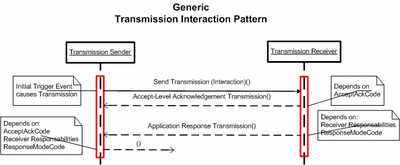Transmission Pattern
A Transmission Pattern is a sequence of interactions which are related, and where the relationship is explicitely conveyed within the Transmission Wrapper.
The figure contains a description of the generic HL7 Transmission interaction pattern. The Transmission Sender (an HL7 Application) sends the initial Transmission. The Transmission Receiver (another HL7 Application) performs an accept-level validation, and sends an accept-level acknowledgement transmission if the Sender had requested such an acknowledgement.
If the initial Transmission is an interaction which has Receiver Responsibilities associated with it (i.e. the HL7 standard specifies that the receiver has to respond to the interaction with a specific response interaction) then the receiver generates and sends the response Transmission. The timing and delivery method of the Response Transmission depends on settings as provided by the Sender with the initial Transmission.
The Transmission Pattern for queries, and the Transmission Pattern for batches differ from the example transmission pattern defined above.
Notes
The link between the initial interaction and the responses related thereto is established by means of the Acknowledgement/TargetTransmission.id attribute of the Transmission Wrapper.
Examples
If an Order interaction is sent, which requests an Accept Level Acknowledgement, and which carries Receiver Responsibilities, then the Order, it's Accept level Acknowledgement, and the interaction sent as a result of the Receiver Responsibilities belong to one and the same Transmission Pattern.
If the Order results in an Observation interaction then that interaction is not part of the same Transmission Pattern. It is actually the initial interaction of a new Transmission Pattern.
